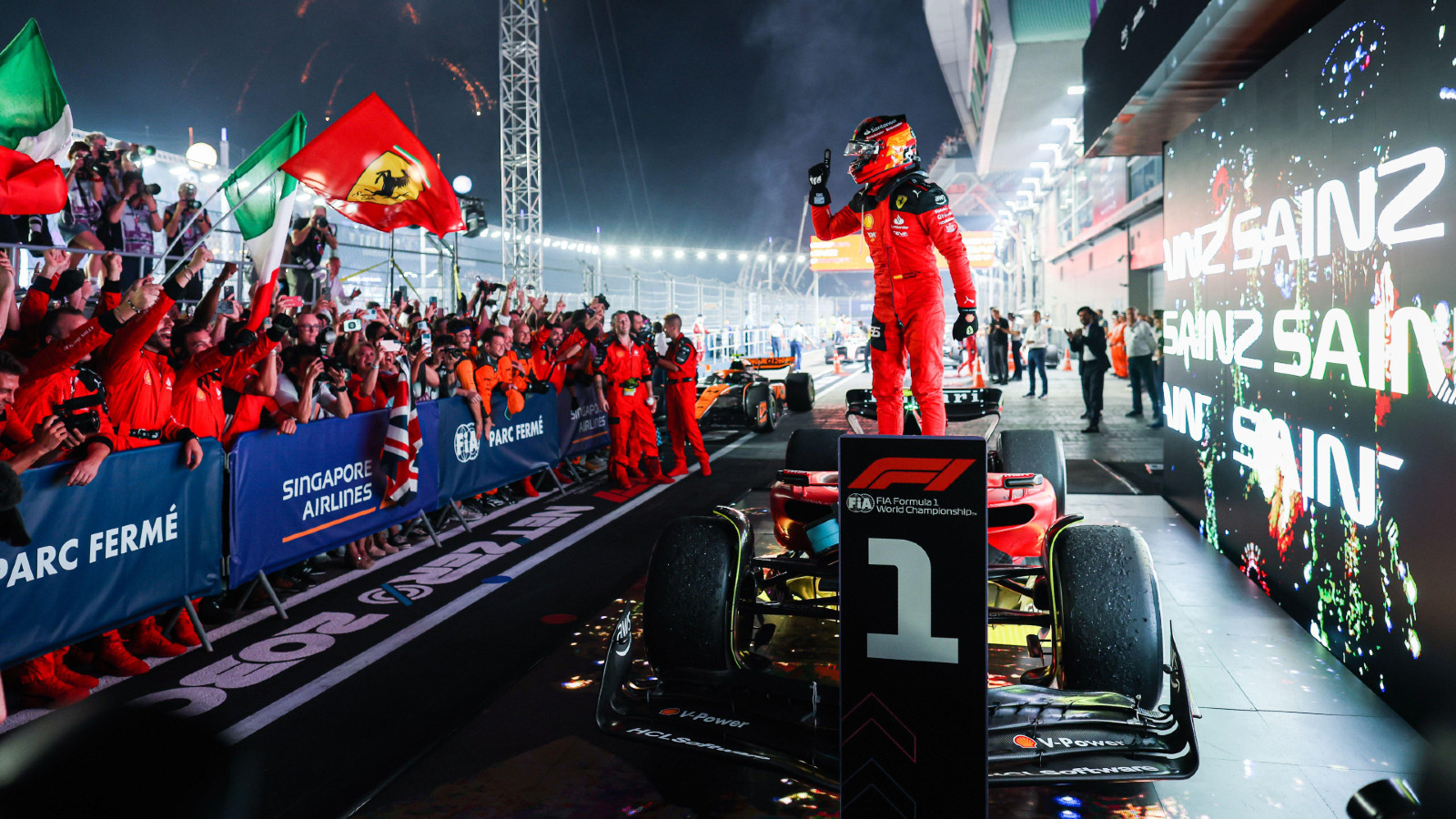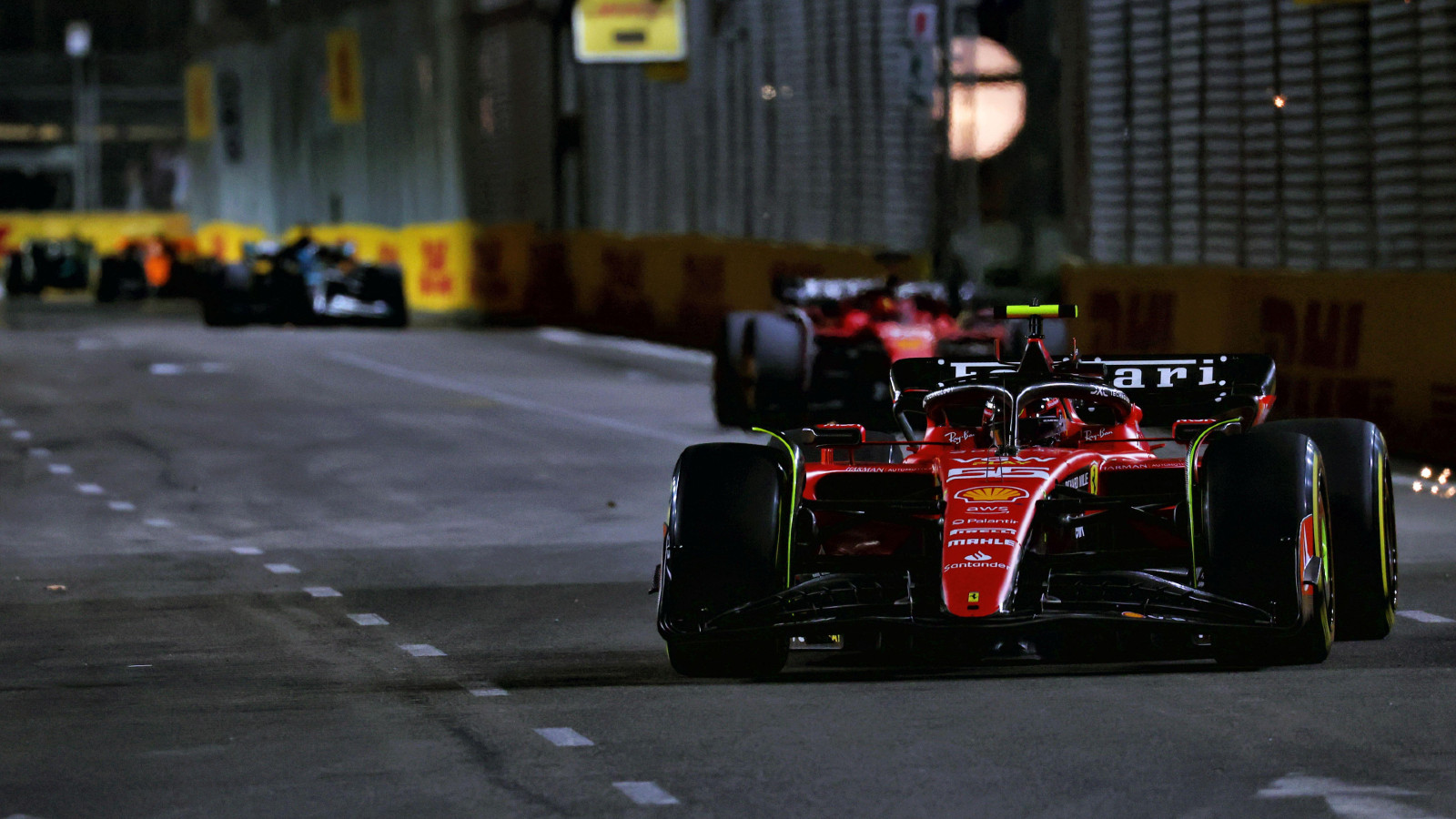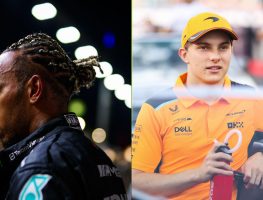Why Carlos Sainz’s win elevates him into F1’s ‘elite’ circle

Ferrari's Carlos Sainz celebrates victory at the Singapore Grand Prix.
Carlos Sainz’s win on the streets of Singapore was easily the most impressive drive of the Spaniard’s career, showing a measured and controlled mettle on his way to the chequered flag.
There’s a particularly famous quote from Alain Prost that typified his measured approach to racing in F1, namely “I always say that my ideal is to get pole with the minimum effort, and to win the race at the slowest speed possible.”
It was an approach that served Prost well. Not that the French driver was slow, by any means, but his composure and calculated approach to racing was in stark contrast to the gung-ho heroics and theatrics that made rival and teammate Ayrton Senna the crowd-pleaser.
Carlos Sainz channeled his inner Alain Prost during the Singapore Grand Prix, coming home with the win after proving unflappable under extreme pressure for most of the race. Having kept Charles Leclerc at bay in Monza two weeks ago, Sainz picked up where he’d left off by controlling the pace of Leclerc throughout the opening stint at Marina Bay.
With Ferrari keenly aware of the danger posed by Red Bull on the hard tyre, Sainz and Leclerc didn’t sprint away from the field as they sought to control the pace – one reason being to keep the tyres alive as long as possible, while also ensuring that their pursuers couldn’t gamble on different strategy options due to the fear of losing track position in such a tightly compacted field.
But while Sainz could be comfortable knowing that Leclerc wasn’t likely to try something silly in the opening stint, he then had to worry about Mercedes’ George Russell through the middle stint and then, later, McLaren’s Lando Norris – a pressure that only escalated in the closing laps as the alternative strategy employed by Mercedes made them look the favourites in the closing laps.
But Sainz, who surely saw his Singapore win slipping away as the Mercedes duo sliced his and Norris’ advantage down to nothing, kept his composure. Knowing that he would fall prey to the charging Russell and Hamilton in a straight fight, and seeing Leclerc fail to impede their progress back towards him, Sainz realised his only hope was to do the opposite to what might seem logical… by slowing down.
Having controlled the pace for strategic reasons to keep his tyres alive earlier, the stakes were so much higher in the final laps – allowing his rivals to latch on would seem counterintuitive in most scenarios, particularly as attempting to sprint away from Norris as his battle with the two Mercedes began was surely a more tempting option.
But Sainz kept his calm, and duly held back a smidge, allowing the trio of cars behind him to get in attack formation. As friendly and chummy as Sainz and Norris are together, it was all-out warfare as the laps agonisingly dripped away, both cognisant of the fact they needed to work together if they were to have any chance of holding off the charge of the irrepressible Mercedes drivers.
The tactic looked like it had failed on Lap 59, as Russell set up the switchback on Norris at Turn 14 – giving him the superior line for the run down the new straight and down to Turn 16. No doubt cursing the fact the teams had failed to reach a consensus on putting in a fourth DRS zone on the new straight, Russell’s move was resisted by Norris – the move being the last proper attack from Russell before his last lap calamity.
With Russell failing to clear Norris and the Mercedes drivers sliding more and more, Sainz was able to count down the laps, and then the corners – what had looked like certain defeat with five laps to go had turned into an against-the-odds win.
Let there be no doubts about it either, unlike his less convincing win at Silverstone last year where circumstances and damage to some of his rivals had given him a little bit of luck – Sainz had gotten the better of Leclerc throughout the weekend, snatching pole position when it counted, and completely controlling the race with exemplary mental fortitude in the face of extreme pressure.

Is Carlos Sainz coming out on top against Charles Leclerc?
Throughout 2021, Sainz and Leclerc had a relatively evenly matched season as the Scuderia drivers regularly hoovered up best of the rest results. But that all changed in 2022 with the switch to the ground-effect and Ferrari’s rise to the front of F1. All of a sudden, Sainz lost his ‘smooth operator’ moniker as his season was plagued by errors, crashes and spins, and a general lack of pace relative to Leclerc.
With the Monégasque underlining his championship credentials for most of the year, Sainz’s reputation took a battering. But the tide has slowly shifted back towards Sainz throughout 2023, with Leclerc showing signs that his development as a driver has stalled out with a car that hasn’t been a world-beater so far this season.
赢面,与此同时,只是似乎课题essed. The silly errors that plagued him last year, his first year in a car that could win races, have all but vanished – in stark contrast to the umpteen errors Leclerc has made. Leclerc may have a smidge more natural speed, but Sainz’s willingness to challenge Ferrari on strategic decisions – as shown en route to his maiden win at Silverstone – has been his forté.
The SF-23 is now a proven race winner, but it’s Sainz, and not Leclerc, who has convincingly achieved it. Sure, Leclerc’s race was undone by his pitstop, but there was never a hint that he was genuinely the quicker man at Marina Bay and, indeed, by the chequered flag, Leclerc was back in the clutches of the once extremely distant Max Verstappen and over 20 seconds behind the purposefully-dawdling Sainz.
Asked whether he feels he has only recently started to unlock the potential of himself and the car, or whether he’s felt he’s made a step forward earlier this year, Sainz said a concerted effort had been made to improve everything over the summer break.
“In terms of car driving and understanding, I think there was a decent feeling with everything before the summer break,” he said.
“我只是坐下来和我的工程师在夏天break and we said ‘OK, what can we do to start putting the whole weekend together?’ because, clearly, we have a lot of pace.
“We were doing some good things, but we are never putting the whole thing together, so let’s see what we can do to improve that and start having consistent performances in the second half because the potential is clearly there, this year.
“Zandvoort was a very good weekend, Monza was almost perfect. Here, I feel like it was the perfect one. It makes me very happy and proud that when you work, you analyse and you also have the speed I’ve had this weekend, it is paying off and we managed to put everything together.”
But, having seen Leclerc ‘sacrificed’ in the opening stint as the soft-shod Ferrari wasn’t given the nod to go ahead of Sainz and was, indeed, told to give Sainz a gap, the Spaniard refuted that Ferrari had put their eggs in the Sainz basket for the win.
PlanetF1.com recommends
F1 Driver of the Day: Who has won the award in F1 2023?
F1 fastest lap: Which drivers have won the most fastest lap points in F1 2023?
“I honestly don’t think the team bet on me,” he said.
“I think we were trying to do the best possible race for both cars and that was coming by obviously Charles keeping a bit of a gap and a bit of a breather in case there was a Safety Car – that is exactly what happened. To be honest, this weekend, I just had a lot of pace and I was feeling at one with the car and I had everything under control.
“Those last five laps before the Safety Car, I managed to extract a lot of pace also out of those medium tyres. I don’t know, I just felt comfortable. I felt everything was under control. And, of course, when you are the lead car, it is always going to be easier.”
勒克莱尔仍可能被视为避邪的number one ‘-type driver at Ferrari, by dint of his natural speed, but Sainz is quickly hauling himself into contention to be taken seriously as Ferrari’s natural leader.
Alain Prost may have ended his career with only half the pole positions of Ayrton Senna, but achieved an enviable win and championship record by dint of making up for his ever-so-slight single lap pace deficit by being exceptionally strong in every other way.
More recently, Nico Rosberg diligently plugged away at improving himself to the point of eventually toppling Lewis Hamilton at Mercedes, and Sainz now is putting in the legwork to be considered an elite-level driver that can lead a team and mould it around him – provided he can keep up the consistency.
Sainz’s win in Singapore is the culmination of months of effort – starting with identifying his weaknesses, acknowledging, and then addressing them. The results of that have been evident in recent races, and victory at one of F1’s toughest venues shows that Sainz is now capable of racing, and beating, the very best drivers F1 has to offer.
Perhaps that’s no surprise. After all, Sainz benefits from the political clout and knowledge that his famous father can bestow upon him from his decades as a top-level driver, and it appears Junior is listening to those lessons – useful weaponry to add to his armoury against Leclerc, who seems content to just blindly accept the circumstances Ferrari outline for him.
Leclerc is no longer looking over his shoulder at Sainz, but now looking directly alongside. Unless Leclerc can start applying himself and learning how to iron out his own inconsistencies as a driver, it’s Sainz, and not Leclerc, who will be the net beneficiary of Ferrari’s gathering momentum.
Read next:WATCH: Joyful moment as Carlos Sainz Snr celebrates son’s Singapore victory






